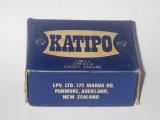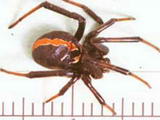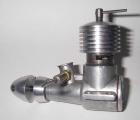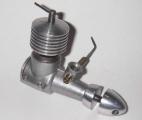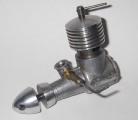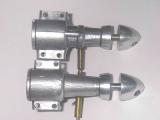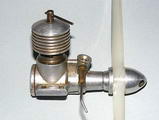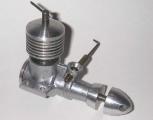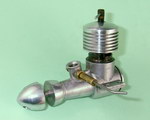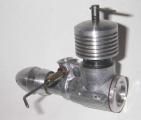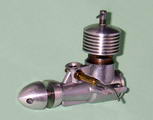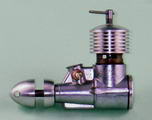Kiwi Kuriosities -
the Katipo Diesels
by Adrian Duncan
2010-10
Revised:
2011-05
Revised:
2013-01
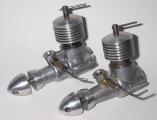 |
||
| Click on images to view larger picture. | ||
Off to New Zealand this time for a look at one of the relatively few commercial model engine lines produced in that country. We'll be examining the Katipo engines, which were a short-lived series of 1.5 cc diesel engines produced in relatively small numbers in Auckland, New Zealand during the latter part of the 1960's.
New Zealand has never been noted as a major model engine producing nation. Indeed, there appear to have been only three serious attempts to establish commercial-scale model engine manufacturing in New Zealand. The first was represented by the pre-war Acme .99 cu. in. spark-ignition model, the second was the highly-regarded post-war Pepperell series and the last was our present subject, the Katipo line. There was a little-known fourth attempt made in the 1950's when Elfin manufacturer Frank Ellis was invited to move his entire manufacturing operation from Liverpool to New Zealand, where a factory would be placed at his disposal. However, the refusal of Frank's wife to relocate meant that this proposal never got off the ground.
The Katipo engines are rarely encountered today, particularly outside New Zealand—our esteemed Editor has characterized them as the proverbial rocking horse droppings! As we shall see, this situation may not be solely related to production volumes. There's also a dearth of published information about these elusive little motors. Time to do what we can to correct this situation!
I've been fortunate enough to have stumbled across a few examples over the years, and have also had some credible inside information about them periodically dropped into my lap from several well-connected sources in New Zealand. My good fortune in both respects has placed me in a position to share a few facts about the Katipo line which appear to be generally little-known. Indeed, some of the very limited published information regarding these engines evidently requires correction!
The following account was based initially on a combination of my own observations with information received many years ago from a single individual. Although this person was seemingly in a position to be quite well-informed on the subject, there was little doubt in my mind that there was more to the Katipo story than he was able to share with me. It was my very sincere hope that the initial publication of this material might jog a few memories and encourage the sharing of further information which could be used to expand or correct this article.
In the above context, it's nice to be able to report that following the initial publication of this article, our hopes were fulfilled through the receipt of further information from two New Zealand residents who were able to add significantly to the story as we had originally set it down. One was Ross Purdy and the other was Chris Murphy. Both of these gentlemen were able to fill in a number of gaps in our tale which will hopefully add interest and credibility to the story. Our most sincere thanks go out to both Ross and Chris.
My initial source of information was Bill Cooksey with whom I was in correspondence way back in May 1980—well over 30 years ago at the present time of writing in January 2013! He was legally blind and corresponded using tapes—amazingly, I still have the relevant tape in playable condition. The 2010 re-discovery of this tape coupled with a number of recent requests for information from present-day collectors inspired me to set about the preparation of this article.
It turns out that Chris Murphy was in contact with Bill Cooksey only a year or two after my own interactions with him. He recalls that Bill was a retired Lieutenant-Colonel in the US Air Force who had relocated to the coastal community of Gisborne, New Zealand. He was apparently a person of strongly-held opinions, right or wrong, with a bit of a tendency towards name-dropping. As far as Chris is aware, he relocated back to the USA towards the end of his life and was heard from no more.
At the time he contacted me, Bill was a long-time MECA member who was looking to trade for a few surplus engines that I had on hand. When he first contacted me, he told me that he might be able to offer a Katipo as a trade item. My immediate response (also by tape) was "Katipo? What the hell's that!" The tape that I still have is his reply to that question. Sometimes being an inveterate packrat pays off.
Thankfully, my openly-admitted ignorance of the Katipo engines encouraged my correspondent to share all that he knew with me, and the surviving tape consists of a quite lengthy monologue on the subject. He began by telling me that the Katipo was a 1960's vintage 1.49 cc diesel made in limited numbers in Auckland, New Zealand by a firm called LPV Ltd. This is confirmed by the address on the box and instruction leaflet that arrived with my subsequently-acquired NIB example—the full address is:
LPV Ltd. 175 Marua Road Panmure, Auckland 6 New Zealand
Panmure is a south-eastern suburb of Auckland located some 11 km from the city centre. Marua Road is still very much in evidence today, and the section around number 175 remains home to several business ventures.
Chris Murphy tells us that the initials LPV stood for "Low Pressure Valves". The name arose from the fact that the previously-established business of the company was the manufacture of various plumbing fittings for domestic and commercial use, in particular shower mixing valves. The company was owned by a certain Mr. Morrie Jensen. Bill Cooksey claimed to have known Mr. Jensen personally prior to his death in August 1979.
Prior to hearing from Chris, I was contacted by another New Zealand resident named Ross Purdy who knew several individuals who had been associated with the Katipo engines. One such individual was Angus MacDonald, former owner of a modelling business called Modelair. It seems that the Katipo engines were in fact made for distribution through Modelair and were thus something of a "house brand" for that company. My thanks to Ross for sharing this information.
The question arises as to the motivation for LPV becoming involved in a manufacturing venture that was so different from their established business line. There's certainly an implication that someone at LPV must have had at least a passing interest in models and model engines. Or perhaps Angus MacDonald and Morrie Jensen were mates and one persuaded the other to get involved.
But over and above that, Chris Murphy has rightly pointed out that there may well have been a perception of a legitimate business opportunity that could net the participants some cold hard cash. At the time, the New Zealand government would have levied both customs duty and sales tax on imported engines. As domestic products, the Katipo engines would have been exempt from these charges and could thus be sold at very competitive prices. Indeed, it's quite possible that the manufacturers may have been eligible for a production subsidy, particularly if export sales formed part of their prospectus.
In addition to the above considerations, there was actually relatively limited import competition on the New Zealand model diesel market. By the late 1960's the glow-plug motor was well and truly in the ascendant, and Chris recalls that only D-C, Webra and Taifun diesels were generally available in local model shops at the time in question. Even most of the Taipans imported into New Zealand from Australia by this time were of the glow-plug variety. ED had already faded away along with the Frog range (although D-C were still producing some Frog models at this time) and PAW's were not generally imported at all, being available only by mail order.
This left the diesel-minded New Zealand modeller with a choice between the expensive Taifun and Webra models, the reasonably priced but rather lacklustre D-C engines and the very inexpensive Katipo. If it had come up to par with the others in quality and performance terms, at least in a sport-flying context, the Katipo should have fared quite well in such a market. However, the various shortcomings of the Katipo became apparent rather quickly, and this prevented it from achieving any great market share—bad news unquestionably travels much faster than good news. If there were ever any plans to offer the engines for export, they came to nothing in the end.
Whatever the motivation for their introduction, it's by no means certain that Morrie Jensen was the designer of the Katipo engines. The name of the actual individual responsible has been lost in the mists of time.
The basis for the engine's name is debatable, but the fact that a katipo is a highly venomous spider peculiar to New Zealand strongly implies that this was a poke at the contemporary Australian Taipan line, which was named after a highly venomous snake indigenous to Australia!
The exact displacement of the engine is a bit ambiguous—the box claims that it's 1.49 cc, but the measured bore and stroke of one of my three Mk I Katipos are 13.36 mm (0.526") x 10.32 mm (0.406") respectively for an actual displacement of 1.45 cc. I know this because I had to rebore it to repair some damage sustained through the time-honored "blade in the ports" approach to cylinder removal! They never learn; I have recently re-checked these figures during the course of a further repair with essentially the same results, allowing for the rebore.
I suspect that the nominal bore and stroke were 17/32" (13.49 mm or 0.531") and 13/32" (10.32 mm or .406") respectively, which would yield a displacement of 1.48 cc. Regardless, this is an unusually short-stroke design, with a bore/stroke ratio of approximately 1.3:1 The short stroke explains the relatively squat and compact appearance of the engine. Despite this compactness, the engine weighs in at a relatively hefty 3.7 ounces (105 gm).
The literature supplied with the engines specifically claims that the motors were "built up to a standard, NOT down to a price". I must say that my NIB examples seem very well made indeed as regards fits and finish, and the best of my other three examples (which remains completely original and appears little used, if at all) is just as well fitted. I've never run of my pristine examples, for reasons which will become apparent below. However, they have probably both had a little running—Bill Cooksey specifically mentioned that all engines were test-run prior to dispatch. Shades of an earlier era.
That being said, Chris Murphy was able to provide a more balanced viewpoint on the basis of actual experience with a far larger sample of engines. When he was a junior in the Dunedin MAC around 1969-72 the Katipo engines had already become objects of derision. Interestingly, this was primarily due to their general inability to start, their tendency towards low compression and their total lack of power in the rare event that one could be made to run. At that stage, Chris recalls nothing being said about fragility. Still, it appears that my rather well-made examples may have been anything but typical.
I was told by Bill Cooksey that there were two versions of the engine, one with Cox-style twin-opposed transfer and exhaust ports and the other with a more "traditional" circumferential porting layout with three transfer and exhaust ports. Both variants were based upon very similar aluminium alloy crankcases which were apparently produced by gravity die-casting. These cases give the impression of being very sturdy indeed, especially that of the three-porter. As we shall see later, Bill was in error in claiming that there were only two versions—in fact, Chris Murphy confirms that Bill himself soon became aware of a third variant, of which more in its place below.
Bill made the comment that the three-port version was significantly less frequently encountered than the two-porter. He stated that the three-port model was the later of the two, and on this point Mike Clanford agrees with him in his useful but frequently-unreliable 1987 book Pictorial A-Z of Model Engines in which illustrations of both models appear on page 105. But of course that book had yet to be published when the taped discussion recorded here took place in 1980.
Once again, Chris Murphy was able to clarify this point for us. He confirmed that the two port design was indeed the original design but that it was fairly quickly found to be mechanically flawed. The cylinder screws into the crankcase and seats on a ledge, and the generously-proportioned transfer flutes fore and aft weaken the lower wall to the extent that when screwed home and fully tightened the cylinder base could distort out of round due to the wedging action of the screw threads, the result being that the engine would become tight over bottom dead centre. It was apparently this problem that led to the redesign of the cylinder porting to the three port version. There's no reason at all to doubt this interpretation of the facts, but I can only say that none of my own two-porters exhibit evidence of this problem.
Regardless, Chris states that the above chain of events led to the three port engines being actually far more commonly encountered in New Zealand than the two port models, in direct contrast to Bill's comments. Chris estimates that he has probably seen 20 examples of the Katipo and owned 4 of them over the past 40 or more years, and the three-port models have predominated throughout.
I subsequently acquired examples of both types, confirming my correspondent's information regarding the nature of the two designs. Quite apart from the comment about the mechanical issues with the cylinder design, there are plenty of other indications of the later origin of the three port model. Although very similar, the three-port case has been somewhat strengthened by comparison with that of the two-porter, with the mounting lugs being thicker and additional reinforcement being added to the main bearing. In addition, the letter K is cast in relief onto the enlarged gusset just behind the intake. There is no identification whatsoever on the two-port cases, which are completely unbraced.
In addition, the photo in the literature with my NIB examples are of a the two-porter even though the engines in boxes are three-porters. The most logical interpretation is that LPV already had a good stock of leaflets for the former two-porter and didn't bother to produce a revised instruction sheet when they updated the design. Hence, I believe it to be entirely appropriate to refer to the two-porter as the Mk I and the origanal version of the three-porter as the Mk II.
Both models use internal flute-type transfers of quite generous proportions which overlap the exhaust to a significant degree. This overlap allowed the designer to use relatively conservative timing for the exhaust ports (approximately 60 degrees each side of bottom dead centre), since the overlapping transfers still remain open for a sufficient period. Accordingly, we would expect these engines to yield quite good torque figures despite their very short stroke. This expectation is fulfilled in practice, as we shall see.
In both variants, the cylinder simply screws into the crankcase to locate on a shelf below the female case threads, and the aluminium alloy cooling jacket in turn screws onto the threaded cylinder top. The backplate in both cases is also a screw-in item. Both cooling jacket and backplate are turned from bar stock—all pretty conventional stuff. The use of a pressed-in gudgeon pin is mandatory if fouling of the transfers is to be avoided—there's no positive "stop" location when the cylinder is screwed in, and the design has to accommodate any final position, just like the Cox series, for example.
The design is a little unusual in terms of the diameter of its crankshaft journal—all of 0.377" (9.60 mm), or a nominal 3/8". This is a relatively massive diameter for a 1.5 cc diesel—some engines of over double the displacement don't have a shaft this big! Mind you, the internal gas passage is pretty large too for a classic diesel of this displacement at 0.218 in (5.54 mm or a nominal 7/32"), so the extra wall thickness should be good for strength. But read on...
The prop driver engages with a self-releasing taper at the front of the shaft. The one unusual feature of this component is the absence of any form of knurling on the face to discourage prop slippage. Presumably this was to provide some protection against shaft damage in the event of a crash. In my own direct experience, prop slippage during starting does not seem to be an issue provided the aluminium alloy spinner nut is securely tightened. In fairness, it must be said that Chris Murphy disagrees with me on this point. In his recollection, these were absolute pains to tighten using the crude Modelair 'Rev' nylon props of the era without slipping. Perhaps it all depended on the material of the prop which was being used.
It appears that user feedback eventually led to the development of an improved prop driver design. Chris Murphy has kindly sent along several images of a Mk II Katipo which has been fitted with an improved prop driver having a somewhat minimal band of knurling on its front face. This appears to be a second variant of the Katipo Mk II which may be encountered.
In all other respects the engines are completely conventional crankshaft front rotary valve models with no remarkable design features. The shaft induction register hole is round rather than squared off, and induction timing is again quite conservative. The crankweb is of plain disc form with no counterweight whatsoever. The hardened steel shaft runs directly in the material of the case. The sturdy alloy con-rod appears to be a forging. The needle valve with its split brass thimble for tension is totally conventional too. The weight of 105 gm (3.7 ounces) is perhaps a little over the odds for a plain-bearing 1.5 cc diesel of its day, but the unusually massive shaft accounts for much of the extra.
I was told by Bill Cooksey that the engines were all produced in the mid to late 1960's and that production had been terminated prior to 1970. This may well be correct. Chris Murphy recalls that the engines were still available in 1969 in his local model shop in Dunedin (Eclipse Radio and Hobbies in Stuart Street), although they had already attracted a reputation as a lemon by that stage and demand must have been falling sharply as a result. It's entirely possible that production may have ceased as of late 1969 as a result of the effect of this negative reputation upon sales. Unsold examples evidently hung about for some time after production actually ended—this is quite the usual thing in such cases. Chris recalls that they were still to be seen in certain model shops until around 1972, at which point they quietly faded away.
There is evidence to the effect that not all examples of the Katipo were quite as bad as their reputation. Several years after the original publication of this article, I acquired another Katipo Mk I (my third) in a trade with Wellington resident Peter Metcalf. Peter told me that he had bought the engine new from a local model shop in 1969 in blissful ignorance of its reputation. Apparently this one started and ran just fine, because Peter encountered no difficulty in running it in on the bench in accordance with the maker�s instructions (30 minutes on an 8x4), after which he mounted it in a control-line model. At the time of the first flight of this model, Peter had a leg in a cast as a result of a motorcycle accident. The model took off just fine, but Peter�s cast prevented him from turning fast enough to keep up, with the inevitable result! The engine was then oiled and put away, not to re-appear for 42 years until Peter read the original article and approached me with a trade offer which I accepted.
This engine remains in fine original condition, with excellent fits throughout following its break-in and single flight. On the single test run which I was bold enough to give it, the little Katipo started up very easily and ran just fine. If they had all been this good and had stayed together, there would have been little about which to complain.
Bill was not sure how many were actually produced, but he stated that the manufacturing took place in batches on a relatively small scale. This is certainly consistent with the present-day scarcity of surviving examples, plus the probability that LPV were carrying on with their other product lines at the same time. They may in fact have made batches of engines simply to utilize their production facilities during slack periods.
The fact that none of the engines carry serial numbers leaves us with no way of coming up with any actual production figures after the fact. Extensive inquiries conducted in New Zealand by Chris Murphy have confirmed that no-one who is still around seems to have any definite knowledge regarding production figures. Based upon the number of these engines which he has encountered over the years, Chris is inclined to think that if all versions are taken into account, the total number must have been at least many hundreds and could perhaps have gone into four figures. It would take numbers of this sort to justify the cost of having a crankcase die produced. Still, by world standards it�s clear that the number manufactured was very small.
The dating supplied by various correspondents is in direct contradiction to the published information in Mike Clanford's A-Z Pictorial, which states on unspecified evidence that the Katipos were made in 1955. This is clearly wrong (Clanford wrong again? Surely not  ). Moreover, the Taipan engines by that name were not around in 1955 to be "poked at" by the Katipo name!
). Moreover, the Taipan engines by that name were not around in 1955 to be "poked at" by the Katipo name!
The reported circumstances under which production was terminated are a little unusual! According to Bill Cooksey, Mr. Jensen somehow ended up with a sizeable batch of crankshafts which were seriously flawed. Some of the bad shafts evidently went into engines of all types; it's not exactly clear how.
According to Mr. Jensen as related to Cooksey, the shafts from this batch were apparently so fragile that they sometimes used to break on a backfire simply while flipping over to start during their factory test! Others failed after a period of use, but one way or another they all failed! Obviously there was a problem either with the material or the heat treatment—as mentioned earlier, the basic shaft design seems unusually sturdy.
It's unclear how this issue arose—could Jensen have got a sub-specification batch of steel and not realized it? Or perhaps he contracted out the heat treatment or even the entire crankshaft production, and the screw-up occurred at that end outside his control. According to Ross Purdy, Angus MacDonald (former owner of Modelair) believes that the problem arose from the shafts being insufficiently tempered and thus brittle. However, in his recollection the original shafts had generally been OK—it was a later batch which let the engines down. How large that batch may have been cannot now be determined.
Regardless, there was Mr. Jensen with a batch of untrustworthy cranks for which he'd presumably paid, plus a growing backlog of engines with broken cranks and no reliable replacements! There must have been a healthy list of claimants under the sixty-day guarantee with which the engines were sold, but Mr. Jensen lacked the parts to refurbish these engines to an acceptable standard and was thus unable to honor the guarantee. He was apparently a stickler for getting things right, and this situation miffed him so much that he decided there and then to withdraw the engine from the market and return to his original product line, simply taking his lumps rather than getting a replacement batch of cranks made up. End of the story, and he died a decade or so later.
It's unclear how many of these bad cranks made it into the hands of modelers, but some certainly did—one of my two Mk I Katipos (the one that I rebored) suffered a major crank failure after only 45 minutes or so of running in my hands following its rebore. The failure took place while the engine was running fairly fast, and the rod was destroyed as well. The engine had clearly done some previous running in the hands of others, so I have no way of knowing how long the crankshaft actually lasted in service.
Oddly, the shaft failed by shearing right across the actual web—rather different from the more usual journal fracture immediately forward of the crankweb or at the crankshaft induction port. The appearance was of a brittle fatigue failure. Clearly there was a chronic problem with either the material or the heat treatment (or perhaps both)—this is why I have no intention of ever running my other two apparently unused examples!
It appears reasonable to deduce that this issue must have contributed significantly to the engine's seeming rarity today. They weren't made in large numbers to begin with, and if a good proportion of them broke their cranks and spares weren't available either because the firm had stopped making them or because there were no "good" cranks available in any case, they probably ended up in the rubbish bin along with all the ones that wouldn't start! The few survivors are the ones that either got "good" cranks or didn't get run much!
On the basis of both my informant's advice and my own experiences, I'd have to strongly caution anyone who was contemplating running one of these engines—there's simply no way of knowing whether or not you have one of the bad cranks! To anyone who's tempted to run one of these out of curiosity or as a bit of flying field one-upmanship, I'd recommend removing the stock crankshaft and making (or having made) a replica replacement out of decent material for running purposes. Otherwise, best left unrun if you want to ensure that they stick around.
The last tid-bit recorded by Bill Cooksey was the reported fact that according to their users the engines "ran like a hairy goat!" when they did run! A Google search on this phrase indicates that it is generally used in Australia and elsewhere to describe the performance of a race-horse that runs badly in a race, presumably reflecting the commonly-held view of the Katipo�s performance in service! Despite this, I can confirm that the two-porter that I've run starts very well indeed (in contrast, it seems, to many of the long-ago originals) and shows good promise, although the new piston which I had to fit beforehand to replace the badly-scored original has never been fully run in and is still a bit tight.
I never completed a trade with Bill Cooksey that involved a Katipo, and as a result I remained in ignorance of what a Katipo actually looked like! The tape went into my "odds and ends" archive, not to be re-discovered until recently.
I subsequently (and at the time unknowingly) got my own first Katipo (the aforementioned and much-abused 2-porter that I later restored and ran until the crank broke) in 1981, over a year after the exchange of information recorded above. It showed up unannounced and unidentified in a box of bits and pieces which was part of a much larger trade. Because it had no markings and was unreported in any of the literature of which I was then aware, I had no idea what it was—there was nothing to connect it with the almost-forgotten tape which was by then languishing in my archives.
Since it seemed to be a relatively un-remarkable design, I didn't do anything with it at the time. Perhaps that's another reason why these things are apparently so rare today—maybe there are a few of them out there but people don't know what they've got because there's no identification and they've never seen a picture?!? Let's hope that this article shakes a few more loose!
In my own case, all of this changed when the NIB three-port engine showed up at a swap meet in 1984. It was of course clearly identified on the box, and I still vaguely recalled the unusual Katipo name from the exchange of four years previously. So I wasted no time in grabbing it! I immediately recognized my neglected 2-porter from the literature in the box, had my wonderful little "Eureka!" moment and set about getting that nearly-forgotten little curiosity back in running condition now that I knew that it was a legitimate collectible with some provenance behind it. Ran well, as it turned out, at least until the crank broke! But a new crank can be made...
The box is interesting in that it's really too small for the engine! The unit will only fit inside with the comp screw and needle removed, and even then it's tight. The instruction leaflet includes a note about assembling the loose components onto the engine.
The second two-porter arrived in 1986, again at a swap meet. It was in much better condition than the other two-porter and seemed more or less unrun, a state in which it remains today. I've only ever seen two other examples in the metal since that time, so I guess I did well to get my paws on these three!
I did eventually get around to making a new crankshaft and conrod for my "runner" Katipo Mk I. I was glad not to have lost the piston as well, since I had already made that once! In fact, the engine ended up with a full set of working components of my own making! This does not affect the originality of the design, however, since I faithfully copied all parts to the very best of my ability. So the external appearance is unchanged and performance should be unaffected—the only difference is that this example can now be run with some expectation that it will survive.
On a re-test after a break-in for its new components, the engine started quite readily, although a light prime was required—choking alone didn't seem to do the job. The little Katipo ran very steadily and was easy to set. Once correctly adjusted, running was very smooth and consistent, with no trace of sagging. The new contra-piston that I made as part of the rebore is still a bit "sticky", but that will ease in time.
Power is nothing special, but there's plenty of urge there for sport-flying purposes. A few sample propeller-rpm figures are as follows:
| Propeller | Speed (rpm) | Power (BHP) |
|---|---|---|
| 8x6 APC GF | 7,700 | 0.086 |
| 8x4 APC GF | 10,200 | 0.116 |
| 7x6 APC GF | 10,800 | 0.130 |
| 7x4 APC GF | 12,500 | 0.127 |
The BHP coefficients supplied by Gordon Cornell for the APC range of props were used to calculate the above BHP figures. They seem to imply a power peak of around 0.142 BHP at 11,800 rpm or thereabouts. Not particularly remarkable, but well in line with typical plain bearing sports diesel performance expectations during the 1960's, and the still-tight rebuilt engine will doubtless improve a little as it frees up some more. The motor clearly produces pretty good torque at moderate revs, and a "fat" 7x6 prop would be the one to use for C/L flying, with a fast 8x4 (the maker's recommended prop) or an 8x3 being well matched for free flight use.
Following the initial publication of this article, I was fortunate enough to acquire yet another NIB example of the engine. I did so because the papers with the engine proclaimed it to be a Mk III Katipo, something of which I had never heard at the time. The identification was hand-written onto the same leaflet which had accompanied the previous two models. but it had the look of an "official" addition rather than an owner identification.
As it turned out, this is indeed a third variant of the engine. In most respects, it is identical to the Mk II version, retaining the three-port cylinder plus all of the other main design features. It's also very well fitted. The major difference appears to be the form of the crankcase casting. As can be seen, the band of material that was cast onto the Mk II case around the main bearing below the intake has disappeared and the web of material beneath the main bearing has been considerably lengthened. In addition, an extra web has been added on the top of the main bearing forward of the intake. The result of these changes should be a further stiffening of the already-sturdy main bearing.
Removal of the backplate reveals that the only readily-apparent internal change is a significant increase in the thickness of the connecting rod. The former rod actually appeared to be fairly substantial for an engine of this displacement, so one can only assume that the makers were trying a stiffer rod to see if this might alleviate the crankshaft breakage issue. The crankshaft appears identical to that used on the Mk II version, and consequently this engine will never be run, at least not by me!
The one rather odd feature of the Mk III is its use of the plain prop driver instead of the improved component seen on Chris Murphy's second variant of the Mk II. Why use a component that had reportedly proved to be problematic when they clearly had a superior item available? The logical inference is that this was part of a final batch of engines that were assemble from parts on hand, and they simply used the earlier prop driver because it was there to be used. There are many precedents for this.
This is the sole example of this variant that has ever crossed my path, and it seems to be by far the least common version of the engine. Nonetheless, I'm sure that there must be others out there. It's hard to imagine that there could be any other variants, but you never know, so if anyone finds another version, please share it with us!
In that context, it seems only fair to report that Bill Cooksey told Chris Murphy that there was indeed another variant which had the letter K cast within a circle onto the cylinder spigot portion of the crankcase. This may or may not be true—all that can be said is that neither Chris nor I have ever seen one in many years of looking!
Conclusion
The Katipo saga is a testament to the way in which the best-laid plans can be derailed by a single set-back. The basic Katipo design was perfectly sound if somewhat less than inspired, and the engines were attractive little units which certainly had the potential to give long and dependable service if they had been manufactured to a consistently higher standard than they were. Had it not been for the accident of the bad crankshafts, they would probably have done just that and would be both far more readily available and far better remembered today. As it was, the 3rd commercial era of New Zealand model engine manufacturing ended somewhat ignominiously. Too bad.
This page designed to look best when using anything but IE!
Please submit all questions and comments to
[email protected]
|
Unless otherwise expressed, all original text, drawings, and photographs created by
Ronald A Chernich appearing on the Model Engine News web site are licensed under a Creative Commons Attribution-Noncommercial-Share Alike 3.0 License. |

|
